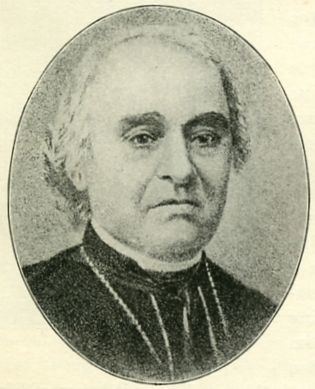Predecessor None (first bishop) See Oregon City | Installed July 24, 1846 Name Francois Blanchet Term ended December 12, 1880 | |
 | ||
François Norbert Blanchet (September 30, 1795 – June 18, 1883) was a French Canadian-born missionary priest and prelate of the Roman Catholic Church who was instrumental in establishing the Catholic Church presence in the Pacific Northwest. He was one of the first Catholic priests to arrive in what was then known as the Oregon Country and subsequently became the first bishop and archbishop of the Archdiocese of Oregon City (now known as the Archdiocese of Portland in Oregon).
Contents
Early life and priesthood
François Norbert Blanchet was born near Saint-Pierre, Rivière du Sud in Lower Canada (present-day Quebec). Along with his younger brother Augustin-Magloire Blanchet, he entered the Seminary of Quebec and was ordained a priest in 1819. Blanchet spent a year working at the cathedral in Quebec before being sent to do missionary work with the Micmac and Acadian people in present-day New Brunswick. To able to preach to the local Irish, Blanchet became fluent English. In 1827 he was summoned back to Montreal and became a pastor.
Missionary work and episcopal career
In the 1830s, John McLoughlin sent letters from French Canadian Catholic employees of the Hudson's Bay Company requesting from bishop Provencher of the Red River colony to send priests to what was then known as the Oregon Country. Bishop Provencher originally suggested that priests be set to the Willamette Valley but the Hudson's Bay Company pressed for the considered mission to be on the Cowlitz River, north of the Columbia River. Blanchet was appointed the Vicar General of the Oregon Country, with fellow priest Modeste Demers to aid in the missionary efforts. The missionaries were instructed by Archbishop Joseph Signay of Quebec to "In order to make yourselves sooner useful to the natives... you will apply yourselves... to the study of the Indian languages... so as to be able to publish a grammar after some of your residence there." The two priests along with nuns and lay people departed from Quebec on May 3, 1838 and traveled along the York Factory Express.

Arriving on 18 November at Fort Nez Percés, a Hudson's Bay Company fur trade outpost located in the present state of Washington where Blanchet celebrated Masses and baptized three Roman Catholic converts. In November of that year, they arrived at Fort Vancouver in present-day Vancouver, Washington. A delegation composed of French-Canadians from the Willamette Valley composed of Pierre Belleque, Joseph Gervais and Étienne Lucier were present to greet them. During their winter stay at the Fort, the priests held services in Chinook Jargon with Klickitats and Cascades in attendance. Blanchet and Demers held Masses in various buildings within the fort, and Catholics often had to share worship space with Protestants, an arrangement that did not please either group.
Beginning on January 3, 1839 Blanchet, with Belleque and Lucier, went to the French Prairie farms maintained by the French-Canadians. The first Catholic Mass south of the Columbia river (in the Oregon Country) was celebrated at the St. Paul church on January 6, where Blanchet remained for five weeks. During his second visit in March 1839 to Cowlitz to visually explain basic Catholic religious concepts Blanchet created the "Sahale stick" or stick from God in Chinook Jargon. This was latter made more complex with the use of cloth, to allow for additional representations. The use of the Sahale stick was later adopted by Methodist and Presbyterians like Daniel Lee and Henry H. Spalding.
In February 1841 several gatherings were convened to determine the fate of recently deceased Ewing Young's estate, the first of the Champoeg Meetings which two years later saw formation of the Provisional Government of Oregon. Jason Lee as chairman of the first meeting on the 17th proposed for a Willamette Valley-based settler government be formed. Included in considered government was the position of governor, which led Blanchet to counter propose a political system with a judge as the highest authority. During the subsequent meeting held at David Leslie’s home near Champoeg during the next day Blanchet was selected to chair a committee to draft the laws of government. Blanchet was still opposed to contemplated political structure, and six months later asked for a reprieve of his duties.
On December 1, 1843, the Vatican under Pope Gregory XVI established the Vicariate Apostolic of the Oregon Territory, and named Blanchet its vicar apostolic. Then on July 24, 1846, the Vatican under Pope Pius IX divided the vicariate apostolic into three dioceses: Oregon City, Vancouver Island, and Walla Walla. Blanchet was named bishop of Oregon City, while Demers was named bishop of Vancouver Island and Augustin Blanchet bishop of Walla Walla. The Diocese of Oregon City was elevated to an archdiocese on July 29, 1850, and François Blanchet was elevated to archbishop.
He died in 1883 and is interred at St. Paul Cemetery in St. Paul, Oregon.
François’s brother was Augustin-Magloire Blanchet, who was the Bishop of Walla Walla until 1850 and then the Bishop of the Diocese of Nesqually, which later became Diocese of Seattle.
Legacy
In 1995, the Archdiocese of Portland approved the plans to build a Catholic secondary school in Salem, Oregon under the condition the school be named Blanchet. Blanchet Catholic School opened in 1995.
